This is a page within the www.staffshomeguard.co.uk website. To see full contents, go to SITE MAP.
MEMORIES
AND INFORMATION - SHROPSHIRE
5th and 6th
SALOP BATTALIONS
and
LT. HAROLD NORMAN TYRER
and his brothers
|
That part of East Shropshire known since the 1970s as
Telford, and nearby small towns and villages, were
defended between 1940 and 1944 by two Home Guard
battalions. The northern part, centred on
Wellington, was the
responsibility of
5th Salop Battalion
under the command of
Lt.-Col. F. H. L. Oldham,
D.S.O. and included in its area, in addition to
Wellington itself,
Oakengates and Dawley.
The southern area fell under the jurisdiction of
the
6th Salop Battalion
with a territory comprising
Broseley, Burwarton,
Ironbridge/Buildwas, Madeley and Much Wenlock
under the command of
Lt-Col. Viscount de Vesci.
These battalions were two out of the eleven in Shropshire, each
battalion
comprising anything between 1000 and 2000 men.
Both of them were part of the Wellington
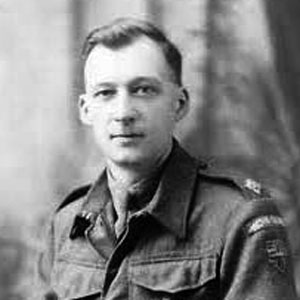 Group
in the county, other members being the
10th Battalion
(responsible for (Shifnal)
and the 11th
(Newport and nearby
villages). Group
in the county, other members being the
10th Battalion
(responsible for (Shifnal)
and the 11th
(Newport and nearby
villages).
One of the local Home Guard men was Lt. Harold
Norman (Norm) Tyrer
(left).
Norman
(b. 1909)
lived at the time in Crown
Street, Dawley with his wife Mary and
worked at a nearby ironworks,
Court Works, Madeley.
The boundary between these two Battalions fell
somewhere between Dawley and Madeley. If Norman
served in the Battalion responsible for the area in
which his home was located, he would have been a
member of the 5th; on the other hand, if he had
elected to join the Court Works factory unit, he would
have been in the 6th and almost certainly a member of
"D" Company of that Battalion whose HQ was the
Market Hall, Madeley.
Close examination of Lt. Tyrer's insignia suggests the
presence of a "6" which of course indicates membership
of the 6th Salop (Madeley) Battalion. (With
thanks to Steven Roberts).
Norman was of course too young to have had the sort of
Great War experience which would have led to many of
his fellow officers and N.C.O.s being appointed to
positions of authority as soon as the Home Guard was
created in May/June 1940. Norman would certainly have
started in the ranks but, clearly, personal qualities
and perhaps specific knowledge and skills must have
made him stand out and resulted in his being
commissioned at some later stage, perhaps in 1942 or
1943.
He is seen below in a studio image with
his 2/Lieutenant's pip clearly visible on his
shoulder. Perhaps this photograph was taken at the
time of his appointment. A proud moment for him and
his family!
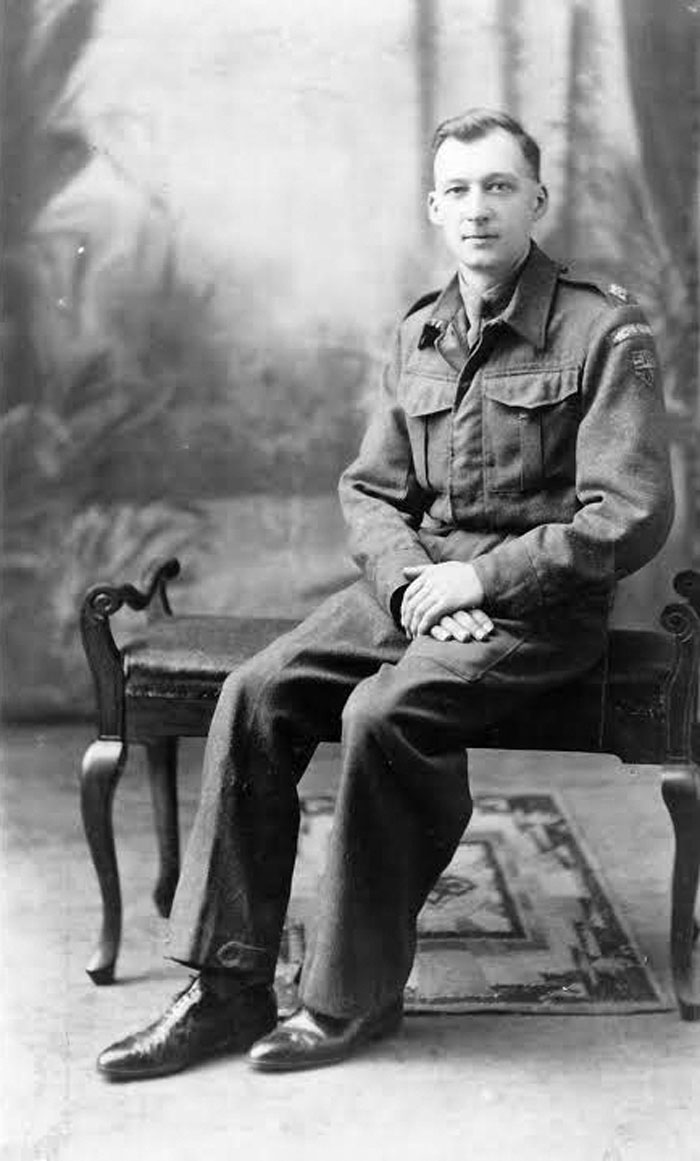
This portrait of Norman clearly shows one
idiosyncracy of the Wellington Group battalions.
Unlike the overwhelming majority of units throughout
the country, and even elsewhere in Shropshire, men in
these units did not wear the normal battalion
identifying badge on their upper arm, which would
otherwise have been "SHR 5" or "SHR 6", with black
letters on khaki. Instead they bore a different
battalion insignia - perhaps designed by themselves? -
usually based on Roman numerals and often including a
Company identification as well. The reason for this
departure from normal, approved practice is unknown.
Perhaps later, Norman is seen with his fellow
officers, perhaps all the officers of one Company. Norman is in the back row, second from the
left. Apart from him, none is so far
identified. (Identification of just one of the older
officers would enable us to re-confirm the Battalion to
which they all belonged, almost certainly the 6th). Date and location are also
unknown.
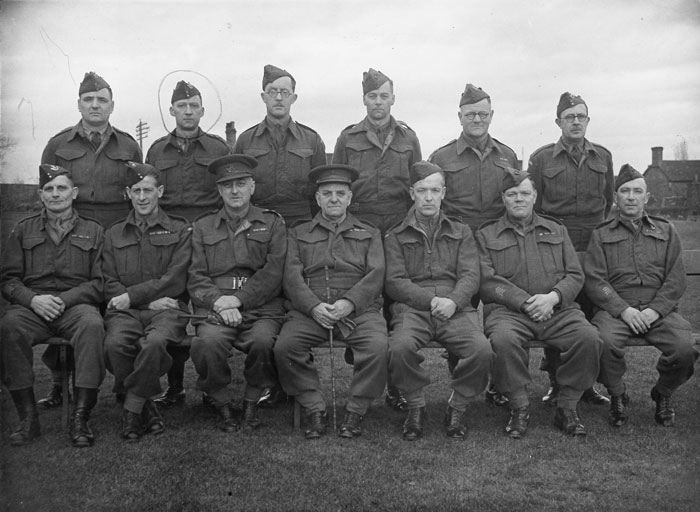
An image also survives showing Norman Tyrer's three
brothers, Albert (Bert) John Tyrer
(b.1905),
Ronald (Ron) Tyrer
(b. 1920)
and Leslie (aka Joe) Tyrer
(b.1908).
Ronald is in RAF uniform and, in 1942, is living in
the Thorne area of
the West Riding of Yorkshire.
Bert and Leslie/Joe, like their brother Norman, are in
the Home Guard and as they are living in the
Madeley area, Leslie
in Park Lane, Madeley,
they are almost certainly members of the 6th
Salop. Bert is a
miner and Leslie/Joe works in the iron foundry at
Coalbrookdale, both
jobs being reserved occupations.
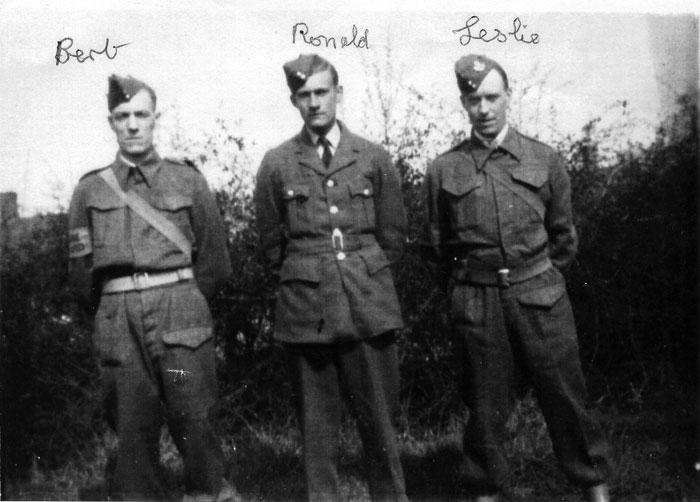
When stand-down came in December 1944, Norman's
contribution was gracefully acknowledged in a letter
from Col. A. W. Turnbull
M.C., writing from The Home Guard - Shropshire
Zone at 2 Claremont
Buildings, Shrewsbury.
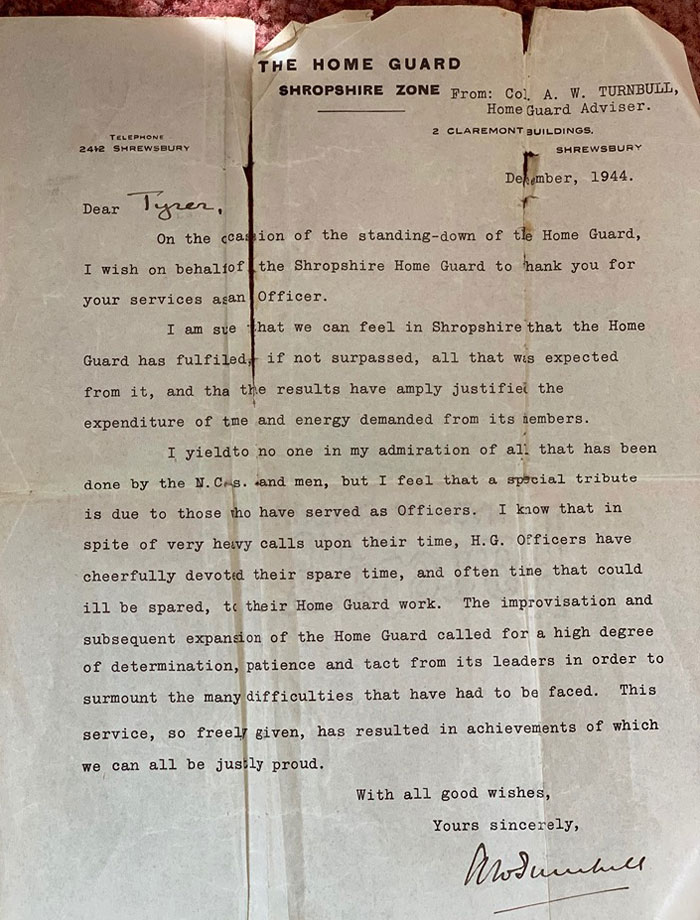
And in due course acknowledgement of Norman's
service came from an even more exalted source, His
Majesty
King George VIth. This confirms that he served from
12th July 1940 up until the end, representing
four-and-a-half long years of arduous, time-consuming
and entirely voluntary effort.
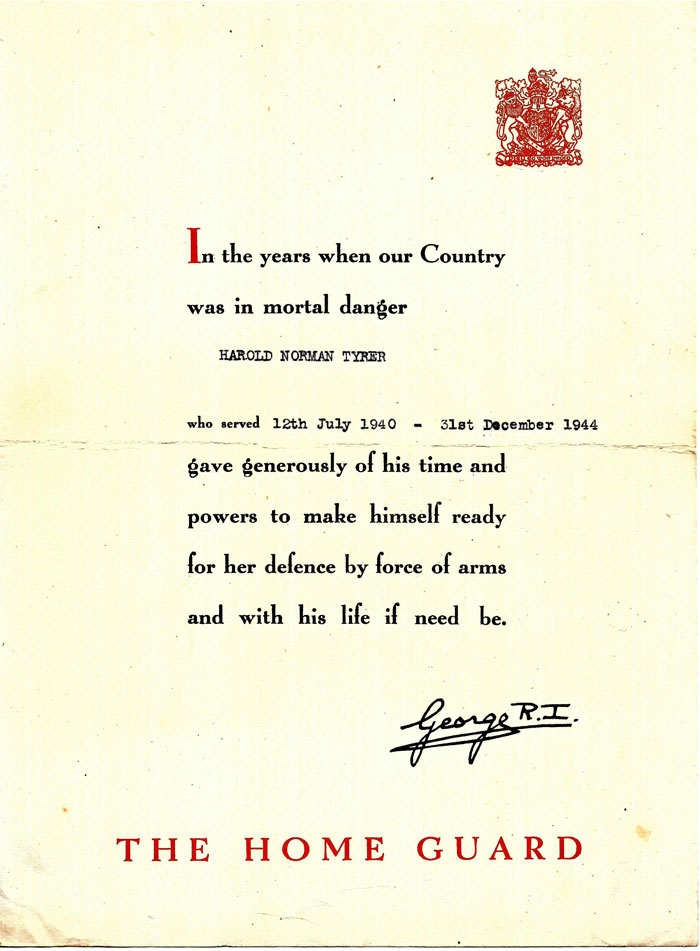
*********************
Let us remember
Harold Norman Tyrer
His brothers
and
All their comrades
who served in the
5th and 6th Salop Battalions
|
ACKNOWLEDGEMENT
is gratefully made
to Shaun Tyrer for the above information
about his father and uncles and his generous permission
for its publication.
Personal images ©
Shaun Tyrer 2018
FURTHER
INFORMATION
Other information about the
Home Guard in Shropshire contained within
this website can be seen in the
Shropshire summary page which can be
accessed via the Memories-Shropshire link below.
Much information about the Home Guard in the county
is also contained in the book
The Shropshire Home Guard by Bernard
Lowry (Logaston Press, 2010, ISBN:
978-1906663 46 9) to which grateful acknowledgement is
also made.
And if you
can add anything to the history of the
Shropshire Home
Guard, and especially the units located in the
area of what is now Telford, please contact staffshomeguard via the
Feedback link. |
x158 March 2018 -
updated June 2019 |
|